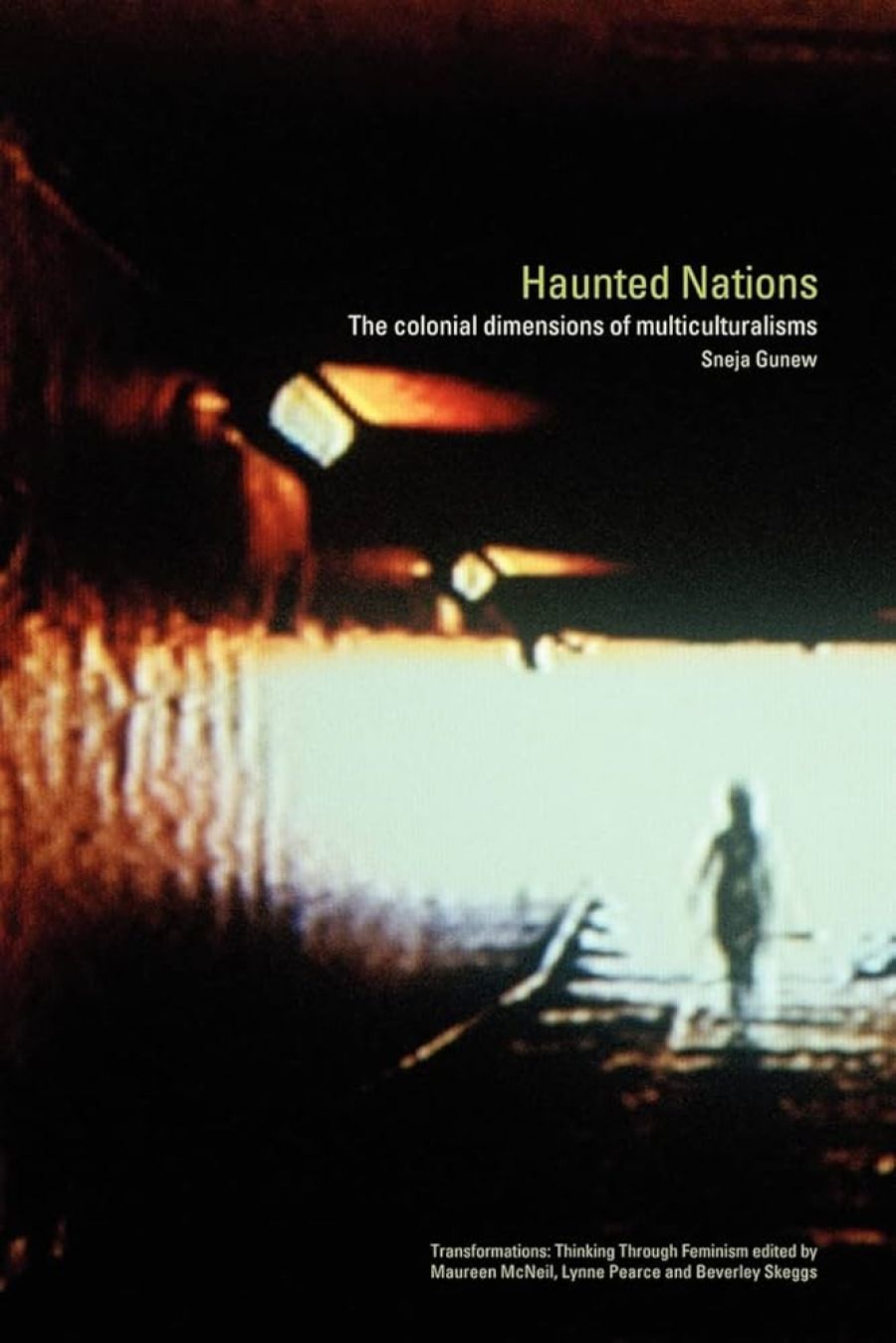
- Free Article: No
- Contents Category: Cultural Studies
- Review Article: Yes
- Article Title: Multicultural Shades
- Online Only: No
- Custom Highlight Text:
Multiculturalism has been in a state of political and theoretical decline for more than a decade. Sneja Gunew’s latest book addresses this loss of political commitment and theoretical engagement with one of the most challenging issues of contemporary society. Her effort to reposition the debate is based on the belief that it is necessary to establish new comparative studies of multiculturalism. In the past, multiculturalism was trapped within a national discourse on identity and rights. This tended to confine debate to pragmatic accounts of social policy, folkloric versions of culture and the classic liberal definition of citizenship. Gunew argues that this approach is inadequate given the global flows and transnational links of diasporic communities. Today, multiculturalism needs to be grasped as a process that is both situated in a specific setting and connected to broader forces. In the context of globalisation, the understanding of multiculturalism requires a more complex model of cultural dynamics and social agency.
- Book 1 Title: Haunted Nations
- Book 1 Subtitle: The colonial dimensions of multiculturalisms
- Book 1 Biblio: Routledge, $63 pb, 179pp, 0 415 28483 X
- Book 1 Cover Small (400 x 600):

- Book 1 Cover (800 x 1200):

Gunew pioneered the study of literary production in Australia’s diasporic communities. From the early 1980s she argued that this work needed to be analysed within a complex theoretical framework that could attend to the complex forms of cultural affiliation and subjective fragmentation. In Haunted Nations: The Colonial Dimensions of Multiculturalisms, she expands the terms of analysis. She not only argues that the cultural production in diasporic contexts represents a distinctive and innovative engagement with the issues of late modernity but that it needs to be aligned with the dis-course on post-colonialism. She acknowledges that this is an uneasy relationship. A number of the activists and theorists that have claimed control over the post-colonial domain would be suspicious, if not outright dismissive, of such an alignment. In their eyes, the concept of multiculturalism is framed by the dictates of state managerialism and cultural co-option. It does not register as a critical and emancipatory concept, but merely as a cage for controlling the unruly forms of cultural difference. Gunew’s aim is to unsettle these stereotypical assumptions of ‘slimy’ multiculturalism and rethink the political and theoretical parameters of cultural difference.
The stigma against multiculturalism is contradictory. The right brands it as a threat to national unity, cultural purity and social stability. On the left, anti-racist activists and some exponents of post-colonial theory argue that multiculturalism is not radical enough. They see it as a covert form of assimilationism that conforms to the exclusionary principles of nation building, a commodification of ethnicity that produces even stronger forms of cultural essentialism and is therefore complicit in the reconfiguration of traditional cultural values that marginalise women and vilify other minorities.
To go beyond this unproductive opposition, Gunew suggests that we need a new conceptual framework that can address the diverse forms of cultural practice in diasporic communities and redefine the way cultural difference is represented within the nation state. The first obstacle that Gunew confronts is the limited and unstable vocabulary for representing difference. In the US, the debates on multiculturalism have been linked to the critique of Eurocentrism in the academy. This has not only limited the sphere in which it operates but has also conflated fundamental distinctions that are powerful markers in other contexts. For instance, in the Australian and Canadian contexts, Gunew notes that the terms ‘Western’ and ‘European’ are not fixed notions of cultural superiority but free-floating signifiers that can have a range of meanings. The linkage to European modernity is an ambivalent sign in Australia. Immigrants from southern or rural European communities were not designated as Western. In the Australian discourse, ‘wogs’ and ‘blacks’ were on a continuum of stigmatisation rather than opposed by virtue of the West versus the Rest binary. The racist mechanisms that sustained such forms of differentiation are never set in concrete. They are fluid and adaptive to the specific cultural terrain in which they operate.
In his analysis of British nationalism, Paul Gilroy also noted a ‘quiet cultural nationalism which pervades the work of some radical thinkers’. Gilroy was particularly sceptical towards the progessivist position taken by Raymond Williams, who presumed that he could set the terms of attachment that minorities needed to demonstrate before they could assume a place in the national imaginary. With considerable acumen and, dare I say, the finely honed resentment of an exile who is returning to unfinished business, Gunew also takes aim at the ‘Labor aristocracy’ in Australian cultural politics. Gunew describes writers such as John Docker and Morag Fraser as displaying ‘an entrenched refusal to take minority cultures seriously’. She argues that the settler versus indigenous paradigm for representing the boundary of exclusion in Australian culture was utilised by these leading figures of the left to both distance the colonial contact zones and avert an interrogation into the internal forms of differentiation. The only forms of cultural difference that such writers can conceive of is that of the absolute otherness of indigenous people whose culture and identity have been wrecked in the collision of colonial conflict. She argues that there is no attempt to address either the legacy of these contact points or the ongoing forms of cultural survival. By reducing the other to silent victim or avoiding any dialogue with internal strangers, the ‘progressive thinkers’ also elevate themselves as sole representatives of the national imaginary. One of Gunew’s greatest achievements has been to expose the blindness in this form of cultural authority.
The biggest challenge that Gunew confronts is in articulating a model of multicultural critical theory, one that could address both the local and global networks of minorities and develop a minority perspective that does not reinscribe the neo-nationalist imaginary. She suggests that this model would not operate in the same grand and schematic forms as earlier forms of radical critique. It would proceed in the form of a supplement, inserting itself in the dominant discourse in order to lever open new modes of representation. It would always define its parameters of influence in modest terms, thereby seeking to deliver on the promise of what Donna Haraway called ‘situated knowledge’. Here the concept of ‘haunting’ enters, not as a spook but as a guide in troubled times. Gunew suggests a mode of thinking that is attentive to complex entanglements between and within different cultures. This lures the focus inwards, but also points to the radial forms of attachments. Such double perspectives never produce fixed and singular forms of identity; they reveal the multiplicities that are at play in all cultures.
These comments on the necessary perspective for multi-multiculturalisms should not be confused for an academic dispute over rival methodologies or for a contest over who defines the national imaginary. I suspect that there is a part of Gunew that no longer cares about the latter, or at least not in the same way she did in the past. This book is bigger than those debates about what is theoretically fashionable and who represents the nation. It is a book about the ethics of living with difference and about the solidarity that is found among strangers. Today, the image of the stranger is not confined to either the migrants locked in detention camps or the rootless cosmopolitans: there are also strangers who are attached to local communities and also part of transnational networks.


Comments powered by CComment